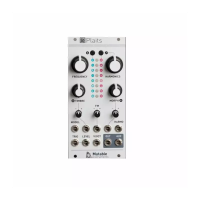MORPH: decay time.
Without any signal patched to the TRIG input, a continuous tone is produced. Not particularly useful, but
its amplitude can still be modulated by the MORPH knob and CV input!
The drum machine emulated on OUT employs a bunch of bridged T-networks, one for each mode of the
shell, excited by a nicely shaped pulse; plus some band-pass filtered noise. As for the signal synthesized
on AUX, it is based on a pair of frequency-modulated sine VCO, mixed with high-pass filtered noise.
HARMONICS: balance of the harmonic and noisy components.
TIMBRE: balance between the different modes of the drum.
MORPH: decay time.
The recipe is similar for both OUT and AUX: a bunch of square oscillators generate a harsh, metallic tone.
The resulting signal is mixed with clocked noise, sent to a HPF, then to a VCA. While OUT uses 6 square
oscillators and a dirty transistor VCA, AUX uses three pairs of square oscillators ring-modulating each
other, and a clean, linear VCA.
HARMONICS: balance of the metallic and filtered noise.
TIMBRE: high-pass filter cutoff.
MORPH: decay time.
The physical and drum models employ their own decay envelope and filter. The internal LPG is disabled
for them:
The TRIG input triggers the synthesis of the signal, but doesn’t strike the LPG.
When the TRIG input is patched, the LEVEL input works as an accent control.
Mutable Instruments | Plaits
9 of 11

